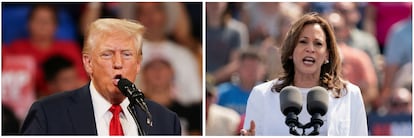Opposing campaign strategies: Harris’ ‘joy’ versus Trump’s ‘We are a failing nation’
After just a few weeks, the Democratic candidate is neck-and-neck with the Republican and is ahead in three swing states, according to a Siena College poll for ‘The New York Times’


“The first party to retire its 80-year-old candidate is going to be the one who wins this election,” predicted then Republican presidential candidate Nikki Haley in January. Seven months later, Democrats — elated by how the Kamala Harris campaign has pulled the party out of its downward spiral — believe that this statement will prove prophetic. Republicans — who only three weeks ago saw were already envisioning themselves in the White House — are keeping their fingers crossed that the former governor will not end up being right.
Since Joe Biden handed the Democratic nomination to Harris on July 21, the race for the White House has been completely transformed. With an excited voter base, a new and diverse leader — the first Black and Indian woman to be a presidential candidate for a party —, money in the coffers and polls in their favor, the Democrats are campaigning with a new slogan: “Joy.” Donald Trump is appealing to voters with a grimmer message: “the only thing standing between you and its obliteration is me.”
The momentum of the Harris campaign seems to have caught Trump off guard, as he had based his campaign on fighting Biden, whom he successfully defined as too “weak, failed and dishonest” to continue in government. Now, in his rallies — he is doing fewer of them compared to his first campaign in 2016 — he has opted for personal insults as a strategy against Harris, calling her “stupid” and “radical” and accusing her of changing her racial identity to win over voters. “We’re substantially leading,” he boasted at a press conference at his Mar-a-Lago residence in Florida on Thursday.
For now, the data is contradicting him. A Siena College poll published by The New York Times on Saturday finds that Harris leads by four percentage points in three key swing states: Michigan, Wisconsin and Pennsylvania, which is essential in the Democrats strategy to win the White House. In all three, the former California attorney general has a voting intention of 50%, compared to Trump’s 46%. The survey also finds that the vice president — who was very unpopular just a month ago — now is more positively viewed than her rival: voters perceive her as more intelligent, more honest and with a better temperament to govern. The Republican, on the other hand, is seen as having a clearer vision for the country.
Other polls have yielded similar results: the aggregate of political polling analyst Nate Silver places the Democrat with 46.3% of voting intention, above Trump’s 43.9%. The specialized blog FiveThirtyEight gives Harris a two percentage point advantage: 45.6% compared to her opponent’s 43.5%.
“For the first time in a long time, Democrats are united and energized, while Republicans are on their heels. Unforced errors from both Trump and his vice presidential nominee J.D. Vance have shifted the media spotlight from Biden’s age to Trump’s liabilities,” Amy Walter, director of the political analysis firm The Cook Political Report, wrote in a report last week.
Both sides are confident they will win. At her rallies, Harris has admitted that the Democrats are “the underdog,” but has also said: “We all clear about what we are up against.” The Republicans believe that her surge in popularity is only temporary and will fade once Harris has to detail her government plans and answer questions about her administration’s performance over the past four years.
The battle for swing states
With Harris and Trump neck and neck in a country almost equally split between the two parties, the battle for the White House between is being fought in a handful of swing states: Pennsylvania, Michigan, Wisconsin (the so-called “Blue wall,” the states in the North that usually vote for the Democrats) and Nevada, Arizona, Georgia and North Carolina, which form the Sun Belt.
The Democrats have the renewed enthusiasm of rank-and-file voters in their favor. According to The New York Times, 87% are excited about their candidate. The Democratic Party says that more than 200,000 volunteers have joined the campaign. Harris rallies — which, during the Biden era, were rare and to small audiences — now fill halls with 15,000 people, figures that the Democrats have not seen since Barack Obama’s victory in 2008. It is no coincidence that the vice president has incorporated several veterans of the Obama campaign into her team, or that her slogans of “joy” and “when we fight, we win” evoke the “hope” and “yes, we can” of the first Black president in the United States.
Democrats have one key strength: finances. In July — particularly after Biden dropped out of the race — they raised more than $310 million, twice as much as their Republican opponents. Last week, in the first 24 hours after Harris announced Minnesota Governor Tim Walz as her running mate, the campaign received more than $36 million in donations.
The vice president also believes that her choice of running mate will help maintain the momentum in the polls. Harris chose the governor, above all, because of his image as a genuine middle-class person, an endearing professor who speaks simply and doesn’t mince his words. She believes that image will attract more centrist voters in the Blue wall. And that the progressive measures that Minnesota has implemented during the governor’s term will convince the more left-wing groups within the party,
The Republicans, for their part, have an advantage in the campaign: the U.S. electoral system. To win the U.S. election, a candidate needs at least 270 votes in the Electoral College. Each state has a certain number of votes in the Electoral College, which is based according to population. While the Democrats usually win the popular vote, it is more difficult for the party to win a majority in the Electoral College.
Republicans also have the advantage of an established candidate who has the overwhelming support of rank-and-file voters and whose message about America in decline connects with the section of the electorate that feels alienated from the system and hurt by Biden-era inflation. “The stock market is CRASHING! Unemployment is RISING! Wars in the Middle East are spiraling OUT OF CONTROL!” read a Trump fundraising email sent last week.
“We are a nation in decline. We are a failing nation. We are a nation that has lost its confidence, lost its willpower and lost its strength,” Trump said at a rally in Atlanta.
In polls, Trump is leading Harris on questions of who would better handle the economy. In the poll published Saturday by The New York Times, he receives 53% compared to 44% for Harris. Voters also trust him more on another of the big issues of the U.S. election, the management of the immigration system and the border: in the same poll, 51% favored Trump on this issue, compared to 46% for Harris.
However, Trump’s running mate, Ohio Senator J. D. Vance, is less established. His campaign debut in July was marred when some of his past comments went viral, in particular his 2021 statements claiming the United States was being run by “childless cat ladies” like Harris. In the poll for The New York Times, in Pennsylvania, Wisconsin and Michigan, a third of those surveyed said they were dissatisfied with Vance’s selection, with 17% saying they were “angry” about the appointment.
There are less than three months to go until the November 5 election. In a campaign as eventful as this year’s, both parties can still turn the tables. Perhaps even several times over. Before the election, there are a number of key events: first, the Democratic National Convention in Chicago starting on August 19, where the party hopes to continue to build momentum among voters. And September 10, there is the first televised debate between the vice president and Trump.
Whether Haley was right in her predictions will become clear in November. It will come down to which campaign best connected with voters: the Democrats with their message of optimism or the Republicans with their message of discontent. “Things look a lot better for Democrats today than they did a few weeks ago, but Trump is looking stronger now than he did in 2020. This is a toss up,” Walter concludes.
Sign up for our weekly newsletter to get more English-language news coverage from EL PAÍS USA Edition
Tu suscripción se está usando en otro dispositivo
¿Quieres añadir otro usuario a tu suscripción?
Si continúas leyendo en este dispositivo, no se podrá leer en el otro.
FlechaTu suscripción se está usando en otro dispositivo y solo puedes acceder a EL PAÍS desde un dispositivo a la vez.
Si quieres compartir tu cuenta, cambia tu suscripción a la modalidad Premium, así podrás añadir otro usuario. Cada uno accederá con su propia cuenta de email, lo que os permitirá personalizar vuestra experiencia en EL PAÍS.
¿Tienes una suscripción de empresa? Accede aquí para contratar más cuentas.
En el caso de no saber quién está usando tu cuenta, te recomendamos cambiar tu contraseña aquí.
Si decides continuar compartiendo tu cuenta, este mensaje se mostrará en tu dispositivo y en el de la otra persona que está usando tu cuenta de forma indefinida, afectando a tu experiencia de lectura. Puedes consultar aquí los términos y condiciones de la suscripción digital.
More information
Archived In
Últimas noticias
Petro claims the ELN was the target of US attack in Venezuela
Maduro counterattacks Trump with rhetoric and announces downing of nine drug trafficking aircraft
‘Ecce Homo’: The miraculous disaster that made a small Spanish town famous
Return to sex testing at the Olympics: IOC edges closer to banning transgender women
Most viewed
- Sinaloa Cartel war is taking its toll on Los Chapitos
- Oona Chaplin: ‘I told James Cameron that I was living in a treehouse and starting a permaculture project with a friend’
- Reinhard Genzel, Nobel laureate in physics: ‘One-minute videos will never give you the truth’
- Why the price of coffee has skyrocketed: from Brazilian plantations to specialty coffee houses
- Silver prices are going crazy: This is what’s fueling the rally










































